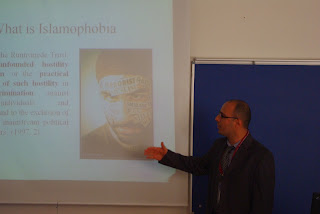I had a possibility to attend the
conference Media Religion Culture 2012 which was held in faculty of
Communication Sciences, in Anadolu University on 8–12th of Julys. I will share
some ideas presented in the conference.
Conference is initiated by the Center for Media, Religion, and Culture which serves as the global secretariat for the biennial international conferences on Media, Religion, and Culture. These series of meetings were initiated by an invitational meeting held in Uppsala, Sweden in 1994 and an international public meeting in 1996 in Boulder, Colorado, launched it as a regular series.
First of all I was surprised
how strict with time Turks were in the conference. It was the first and actually
the last time when Turkish people forced others to be faster, sometimes even
interrupted the speakers because of not enough time left. I should have
recorded those moments.
On the other hand, I was
really disappointed by what I heard in one of the American professor‘s
presentation. No matter what, I will always consider the USA open and steadily
rising country in all the fields which have made impact on huge number of
countries.
Anyway, presentation was called What is Islamophobia? and out of the
blue (I don’t remember an exact question) a discussion started questioning
where the education was better – in the East or the West. And the lecturer told
us to look around, everybody is going to the USA, sometimes to the United
Kingdom, it’s obvious that everybody wants to study here because it’s the best
place for this. Woman who asked a question of course said that she disapproves of
this and discussion was over: “I think we value education differently”. It shows how sometimes even highly educated
people are so narrow – minded and there is a need of these platforms for
discussion.
To be sure that these stereotypes
are alive you can watch films called Hope and a Little Sugar (2006), Kuda Kay
Liye (2007), New York (2009), My name is Khan (2010), Five Minarets in New York
(2010). The films offer an alternative view to the one that is repeatedly shown
by Hollywood on Muslims, Islamophobia and 9/11 attacks. It is really hard to
change point of view of a lot of people because they are sure that every Arab
is a terrorist or Osama bin Laden relative. The protagonist of the movie “My name is Khan” asserts “My name is
Khan and I’m not a terrorist”.
Some insights from
presentations:
· You could feel impact of
Facebook in a lot of presentations. Yes, at this moment we advertise ourselves
on Social Media, but what will happen when we die? Our profile will still be
open for visitors? It‘s like dream machine or line for the heaven?
· Talking about computer games a
lot them like Flower (2009), Journey (2012) are based on killing somebody in
the church. So how it will affect children‘s unconsciousness who play it?
· Presentation about the moustache
and the beard from one young professor who made her presentation for the first
time was kind of successful. They are symbols signifying masculinity and power
of patriarchal men and traditional Turkish and Islamic society. This cultural
sign has been taking different forms according to socio-political conditions of
the time in every situation and circumstance and has been transformed into a political
accessory reflecting various ideologies. For instance, during the period named
the 1968 generation known as the student riots, the moustache became a sign to
show political party people coming from different ranks of society support. Another
important point is that every moustache style has been transformed into a
political accessory reflecting various ideologies.
· One most of the important
discussions were about creating a link between advertising and religion.
Advertising and religion have problematical dimensions. There are aspects which
are anathema to religious ethics. One is whether God and religious symbols in
general constitute effective means for selling and marketing mammon or products
in the secular marketplace. Another is whether God should sell in other words
how theology perceives the act of selling, marketing and advertising. Contemporary
religions promote themselves through modern advertising and if so how they do
it. Yet another question is whether religions relate positively or not to the
advertisement and the act of advertising.
As the conference finished all
those bits of insights and thoughts suddenly fell into one picture. It seems
that the main source of discord is ignorance and political interests rather than
religious or cultural differences.
If you are interested, you can
find information and names of speakers on this website.



Komentarų nėra:
Rašyti komentarą